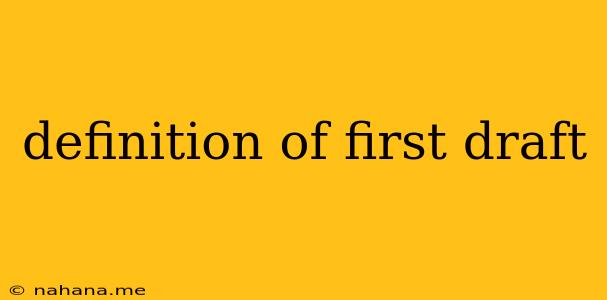A first draft is the initial version of a written work, such as an essay, article, book, or screenplay. It is the first attempt to put your ideas down on paper (or in a digital document) and should not be expected to be perfect.
What are the Characteristics of a First Draft?
- Rough and Imperfect: The first draft is often full of errors in grammar, spelling, and punctuation. It may also be disorganized, lack clarity, and have gaps in logic.
- Focused on Content: The primary focus of a first draft is to get your ideas down on paper. You should not worry too much about style or grammar at this stage.
- A Work in Progress: The first draft is just the beginning of the writing process. It will be revised and edited several times before it is considered finished.
Why is Writing a First Draft Important?
- Getting Ideas Out: The first draft allows you to get your ideas out of your head and onto paper. This can help you to clarify your thoughts and identify areas that need further development.
- Building a Foundation: The first draft serves as a foundation for the rest of the writing process. It gives you something concrete to work with as you revise and edit.
- Overcoming Writer's Block: Writing a first draft can help you overcome writer's block by allowing you to break down the writing process into smaller, more manageable steps.
Tips for Writing a First Draft
- Set Realistic Goals: Don't try to write the perfect first draft in one sitting. Break down your writing into smaller tasks and focus on completing one section at a time.
- Don't Edit as You Write: Focus on getting your ideas down on paper. Save the editing for later.
- Embrace Imperfection: Remember that the first draft is just a starting point. It's okay if it's not perfect.
- Focus on Content: Don't get bogged down in details like grammar and punctuation. Just focus on getting your message across.
- Keep Writing: Don't give up if you get stuck. Just keep writing and don't worry about making mistakes.
Moving Beyond the First Draft
Once you have a completed first draft, you can begin the process of revising and editing. This involves:
- Re-reading and Evaluating: Read your draft critically and identify areas that need improvement.
- Organizing and Structuring: Ensure your writing is well-organized and follows a logical flow.
- Clarifying and Refining: Make sure your ideas are clear, concise, and well-supported.
- Proofreading and Editing: Check for errors in grammar, spelling, and punctuation.
The first draft is a crucial step in the writing process. By understanding its purpose and following the tips above, you can create a strong foundation for your writing and produce your best work.
